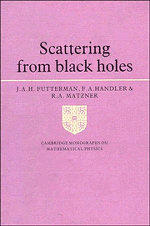Book contents
- Frontmatter
- Contents
- Acknowledgements
- Foreword
- 1 Introduction
- 2 Perturbations of black hole spacetimes
- 3 Integral spin plane waves in black hole spacetimes
- 4 Neutrino plane waves
- 5 Scattering
- 6 Limiting cross sections
- 7 Computation of cross sections
- 8 Absorption, phase shifts and cross sections for gravitational waves
- 9 Conclusion
- Appendix A1 Integrals used to express plane waves in terms of spin-weighted spheroidal functions
- Appendix A2 Addition formulae for spin-weighted spherical angular functions
- Appendix B
- References
- Index
4 - Neutrino plane waves
Published online by Cambridge University Press: 04 August 2010
- Frontmatter
- Contents
- Acknowledgements
- Foreword
- 1 Introduction
- 2 Perturbations of black hole spacetimes
- 3 Integral spin plane waves in black hole spacetimes
- 4 Neutrino plane waves
- 5 Scattering
- 6 Limiting cross sections
- 7 Computation of cross sections
- 8 Absorption, phase shifts and cross sections for gravitational waves
- 9 Conclusion
- Appendix A1 Integrals used to express plane waves in terms of spin-weighted spheroidal functions
- Appendix A2 Addition formulae for spin-weighted spherical angular functions
- Appendix B
- References
- Index
Summary
Introduction
There is no potential for the neutrino field, which means that one must work directly with the field quantities which have a more complicated asymptotic power-law behavior in (1/r) than either metric perturbations or the vector potential. The peeling theorem (cf section 2.4) predicts that we will have to deal with asymptotic solutions differing by one power of r at infinity.
This complicates the integrations necessary to perform the mode-expansions. In addition the neutrino fields transform under changes of coordinates and tetrads in a more complicated way than do vector or tensor quantities. Both of these features are due to the neutrino's intrinsic spin-½ character.
The interaction of neutrinos and gravitational fields was first studied by Brill & Wheeler (1957), who investigated several aspects of that problem including the bound states of neutrinos in a spherically symmetric gravitational field.
More recently neutrinos in the Kerr background have been studied by Unruh (1973), Teukolsky (1973), Chandrasekhar (1976) and Chandrasekhar & Detweiler (1977). The results of these investigations are summarized in Chandrasekhar (1979b; 1983). Briefly, the two-component neutrino and Dirac equations have been shown to be separable in the Kerr geometry, and it has been shown that unlike integer spin fields, neutrinos and electrons do not exhibit classical superradiance in the Kerr background.
In this chapter we expand neutrino plane waves in the normal modes appropriate to the Kerr geometry. We give an elementary account of electron and neutrino plane waves in the NP formalism in flat spacetime. We then transform the flat spacetime plane waves to a tetrad and coordinate system appropriate to the asymptotic Kerr geometry, expand in spin-½ spheroidal harmonics, and match to normal mode expansions.
- Type
- Chapter
- Information
- Scattering from Black Holes , pp. 52 - 69Publisher: Cambridge University PressPrint publication year: 1988



